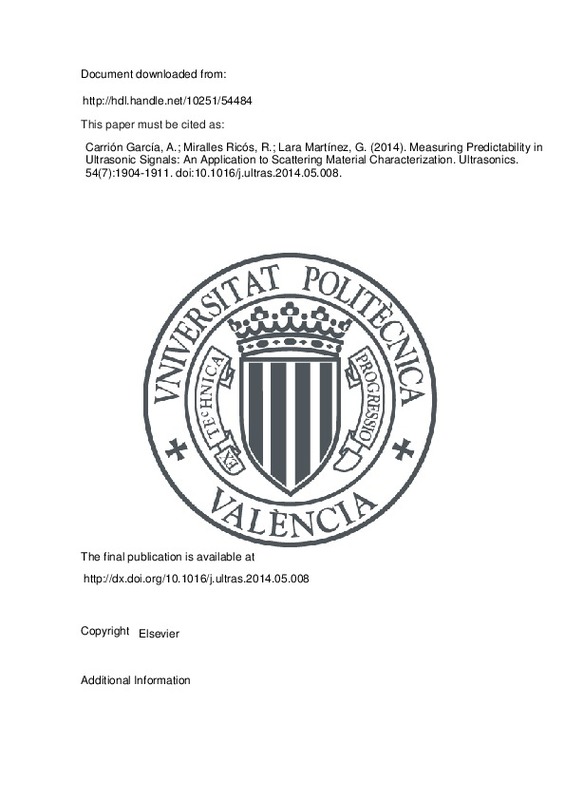JavaScript is disabled for your browser. Some features of this site may not work without it.
Buscar en RiuNet
Listar
Mi cuenta
Estadísticas
Ayuda RiuNet
Admin. UPV
Measuring Predictability in Ultrasonic Signals: An Application to Scattering Material Characterization
Mostrar el registro sencillo del ítem
Ficheros en el ítem
| dc.contributor.author | Carrión García, Alicia
|
es_ES |
| dc.contributor.author | Miralles Ricós, Ramón
|
es_ES |
| dc.contributor.author | Lara Martínez, Guillermo-Fernán
|
es_ES |
| dc.date.accessioned | 2015-09-10T10:47:58Z | |
| dc.date.available | 2015-09-10T10:47:58Z | |
| dc.date.issued | 2014-09 | |
| dc.identifier.issn | 0041-624X | |
| dc.identifier.uri | http://hdl.handle.net/10251/54484 | |
| dc.description.abstract | [EN] In this paper, we present a novel and completely different approach to the problem of scattering material characterization: measuring the degree of predictability of the time series. Measuring predictability can provide information of the signal strength of the deterministic component of the time series in relation to the whole time series acquired. This relationship can provide information about coherent reflections in material grains with respect to the rest of incoherent noises that typically appear in non-destructive testing using ultrasonics. This is a non-parametric technique commonly used in chaos theory that does not require making any kind of assumptions about attenuation profiles. In highly scattering media (low SNR), it has been shown theoretically that the degree of predictability allows material characterization. The experimental results obtained in this work with 32 cement probes of 4 different porosities demonstrate the ability of this technique to do classification. It has also been shown that, in this particular application, the measurement of predictability can be used as an indicator of the percentages of porosity of the test samples with great accuracy. | es_ES |
| dc.description.sponsorship | This work has been supported by the Spanish Administration under grant TEC2011-23403. We also wish to acknowledge Dr. Jorge Gosalbez for providing the ultrasound data of the cement paste probes. | |
| dc.language | Inglés | es_ES |
| dc.publisher | Elsevier | es_ES |
| dc.relation.ispartof | Ultrasonics | es_ES |
| dc.rights | Reserva de todos los derechos | es_ES |
| dc.subject | Ultrasonic signal modality | es_ES |
| dc.subject | Ultrasonic NDT | es_ES |
| dc.subject | Multiple scattering noise | es_ES |
| dc.subject | Determinism | es_ES |
| dc.subject | Higher order statistics | es_ES |
| dc.subject.classification | TEORIA DE LA SEÑAL Y COMUNICACIONES | es_ES |
| dc.title | Measuring Predictability in Ultrasonic Signals: An Application to Scattering Material Characterization | es_ES |
| dc.type | Artículo | es_ES |
| dc.identifier.doi | 10.1016/j.ultras.2014.05.008 | |
| dc.relation.projectID | info:eu-repo/grantAgreement/MICINN//TEC2011-23403/ES/ALGORITMOS PARA EL ANALISIS DE MODALIDAD DE SEÑAL: APLICACION EN EL PROCESADO AVANZADO DE SEÑALES ACUSTICAS/ | es_ES |
| dc.rights.accessRights | Abierto | es_ES |
| dc.contributor.affiliation | Universitat Politècnica de València. Instituto Universitario de Telecomunicación y Aplicaciones Multimedia - Institut Universitari de Telecomunicacions i Aplicacions Multimèdia | es_ES |
| dc.contributor.affiliation | Universitat Politècnica de València. Departamento de Comunicaciones - Departament de Comunicacions | es_ES |
| dc.description.bibliographicCitation | Carrión García, A.; Miralles Ricós, R.; Lara Martínez, G. (2014). Measuring Predictability in Ultrasonic Signals: An Application to Scattering Material Characterization. Ultrasonics. 54(7):1904-1911. https://doi.org/10.1016/j.ultras.2014.05.008 | es_ES |
| dc.description.accrualMethod | S | es_ES |
| dc.relation.publisherversion | http://dx.doi.org/10.1016/j.ultras.2014.05.008 | es_ES |
| dc.description.upvformatpinicio | 1904 | es_ES |
| dc.description.upvformatpfin | 1911 | es_ES |
| dc.type.version | info:eu-repo/semantics/publishedVersion | es_ES |
| dc.description.volume | 54 | es_ES |
| dc.description.issue | 7 | es_ES |
| dc.relation.senia | 269179 | es_ES |
| dc.identifier.pmid | 24952468 | |
| dc.contributor.funder | Ministerio de Ciencia e Innovación |







![[Cerrado]](/themes/UPV/images/candado.png)

